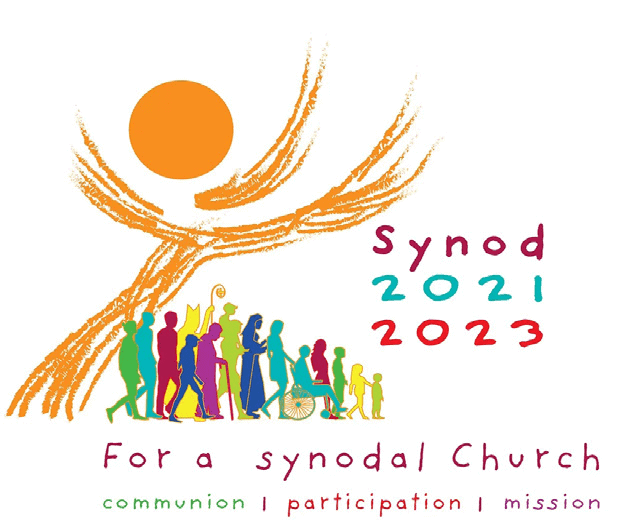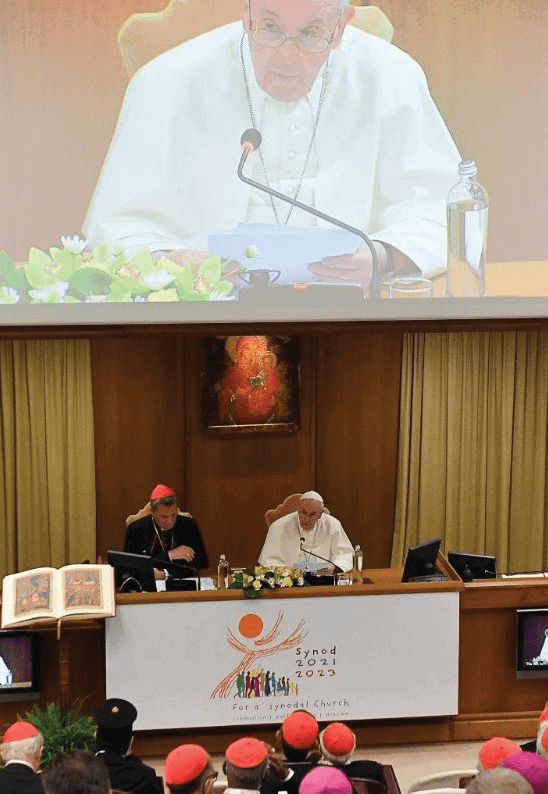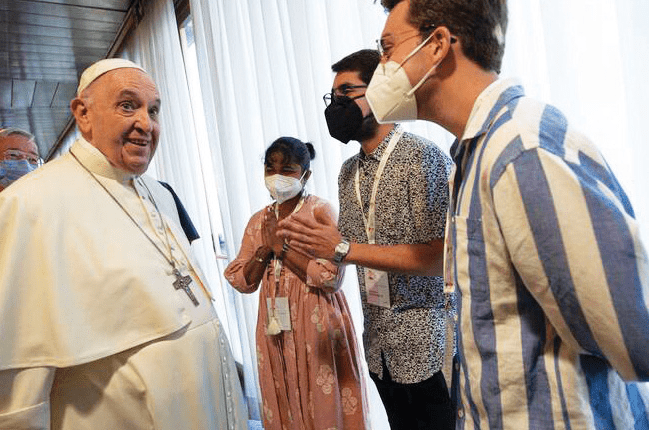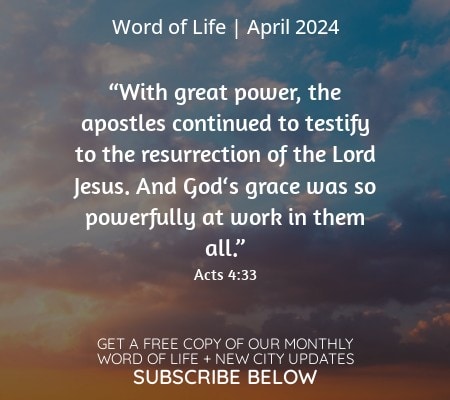
On October 10, 2021, Pope Francis launched a two-year process of preparation for the 26th Synod of Bishops.1 The theme of the synod is “Towards a Synodal Church: Communion, Participation and Mission.” According to the preparatory document:
“Pope Francis invites the entire Church to reflect on a theme that is decisive for its life and mission: it is precisely this path of synodality which God expects of the Church of the Third Millennium. This journey, which follows in the wake of the Church’s renewal proposed by Vatican II,2 is both a gift and a task: by journeying together and reflecting together on the journey that has been made, the Church will be able to learn from her experiences and identify which processes can help her to live in communion, achieve participation, and open herself to mission. Our journeying together is, in fact, what most effectively enacts and manifests the nature of the Church as a pilgrim and missionary People of God.”
The process of preparing for the synod is unprecedented since it involves listening not just to the bishops, but to members of the Church at the diocesan and regional levels. Instead of the usual top-down approach, what we are witnessing is a bottom-up process. It is more inclusive and participative. There have been synods since the early period of the Church up to the present (at diocesan, regional and worldwide levels). These have been participated in mostly by bishops and other Church leaders. Now the process involves listening to the faithful. It reflects what the Church is called to be – a synodal Church – a community that walks together, that journeys together.
Although the term “synodal Church” appears to be a neologism – a new way of referring to the Church – it is by no means a new vision of the Church or the latest ecclesiology.3 It is actually based on the vision of a renewed Church promoted by Vatican II which can be summed up as the Church as Communion and People of God, filled with the Holy Spirit, participating in Christ’s mission as priest, prophet and king (servant). Hence, the “synodal Church” cannot be taken in isolation or be separate from “communion, participation and mission.”
A deeper understanding of what it means to be Church as communion that actively participates in Christ’s mission as a priestly, prophetic and kingly people is needed, as well as an assessment on how we have lived this ecclesiological vision over the last half-century. Then we search for how we continue to live this in new ways now and in the decades to come, especially amid the pandemic and climate change. Let us remember that we live in the age of Vatican II reforms, and its reception and implementation is a continuing process.
A synodal Church is the pilgrim community of Christ’s disciples who live in communion and actively participate in Christ’s mission: a prophetic, priestly and kingly/servant mission. This is the proper context for discerning, deciding, and acting together as a Christian community at all levels – from the local, regional, and universal levels. It is all about living in communion, about participation in mission, and not just governance. It is both relationship-oriented as well as mission-oriented. It is action-oriented, not just a matter of talking and discussing. The process is important, but so also is the outcome. The synodality of the Church is not just limited to what we do leading up to the Synod of Bishops in 2023. It is not just coming up with a new, inspiring document that would be forgotten after the synod. It is a continuing journey of making the Vatican II vision of a renewed Church a reality in our life and for the coming generation. What is the ecclesiological vision of the Synodal Church, and how do we live it?
The Church as a Pilgrim People
The term “synod” comes from the image of journeying together – of walking together. The Dogmatic Constitution on the Church – Lumen Gentium – emphasizes that the Church is a pilgrim people that journeys towards her final destiny – the reign of God. The image of pilgrimage and journeying together is important. We are constantly on the move. We journey together.
There are two ecclesiological themes associated with the pilgrim people: Communion and People of God. Communion is primarily relational – how the members of the pilgrim community relate to one another and with the Triune God. People of God is mission-oriented: participation in Christ’s prophetic, priestly, and kingly/servant mission. Thus, we can say that the synodal Church is a pilgrim community whose members live in communion and participate in Christ’s mission as a priestly, prophetic and kingly people of God.
Living in Communion

In the Vatican II document, the Dogmatic Constitution on the Church (Lumen Gentium ), the term “communion” appears in the first chapter under the general heading The Mystery of the Church. In the first article, the Church is regarded as the sacrament of communion: “since the Church, is in the nature of sacrament – a sign and instrument, that is, of communion with God and unity among all men.” (LG 1) The vertical and horizontal dimension of communion is explicitly affirmed here. The end of the fourth article echoes St. Cyprian when it declares that “the universal Church is seen to be ‘a people brought into unity from the unity of the Father, the Son and the Holy Spirit’ ”(LG 4 citing St. Cyprian, De Dom. orat. 23: PL 4, 553). Here, the Trinitarian communion is affirmed as the basis of ecclesial communion.
What does communion mean and imply? The Latin equivalent is communio which is a translation of the Greek word koinonia which connotes having something in common, being connected by a common bond, union, solidarity, fellowship, kinship, fraternity, community, partnership, sharing, and participation. Among Greeks, it is often associated with friendship: “friends are of one heart and mind, and they share everything in common” (Nicomachean Ethics, Acts of the Apostles).
From an ecclesiological perspective, communion emerged as the earliest model of the Church (Acts 2:42-47, 4:32-35) – the fellowship of believers, communion of faith, table-fellowship, and communion of goods. This was later eclipsed by the institutional model of the Church although its spirit was preserved in religious life through the centuries. The model of the Church as communion was retrieved in Vatican II, especially in Lumen Gentium, which became the dominant ecclesiology connected with the People of God. “The Church is a people made one by the unity of the Father, the Son and the Holy Spirit.” Ecclesial communion is, therefore, the reflection of Trinitarian communion. In the document on ecumenism – Ut Unum Sint – the restoration of full communion is the goal of ecumenical dialogue. St. John Paul II associates communion with consecrated life in Vita Consecrata. In Familiaris Consortio, he affirms the realization of communion in the family which is the domestic church.
The understanding of communion in Vatican II is broad indeed. It describes primarily the nature of the Church and also how it should be structured. It refers to the various dimensions and levels of communion – with the Triune God, among the faithful, among the hierarchy,4 between local churches, within local churches, and in local communities. It is also the goal of ecumenical dialogue. It is the basis of collegiality5 and synodality. The communion model is an alternative to the pyramidal model of the Church. The Church is viewed as an interconnected network or web of relationships – a communion of communions or communities at various levels. Communion means unity in diversity, and equality in dignity of all that constitutes the Church.
To be a synodal Church is, therefore, a Church where everyone lives in communion. The Church is experienced as community where there is a sense of belonging and solidarity, where we regard one another as brothers and sisters, and as friends, where we share our goods and resources – our time, talent and treasure. This means partnership and participation not just in governance, but especially in mission. The role of the clergy is to be servant-leaders and to promote communion and participation in mission.
Participation and Mission

We are called to participate in the Church’s journey as a pilgrim people. Participation is an integral aspect of communion and geared towards mission. To be in communion is to actively participate in the life and mission of the Church. According to Vatican II, by virtue of our baptism, we are united to Christ and his Church and empowered by the Holy Spirit to actively participate in Christ’s and the Church’s priestly, prophetic and kingly/servant mission.
This means that in a synodal Church there is active participation of everyone in the liturgical celebration as a priestly people and community. This also means participation in living a holy life, a life of prayer and self-sacrifice. The role of the priest is to preside over the Eucharistic community and enable the lay faithful to actively live out their priestly mission.
A synodal Church is where there is unity in faith and where all participate actively in the prophetic mission – a mission of evangelization and proclaiming the Good News of salvation and liberation, of announcing the gospel of life, justice, and peace. This also includes the mission of denouncing evil in all its manifestations in society and calling people to conversion. This prophetic mission includes catechesis and education. The role of the priest is to lead and enable the faithful in exercising their prophetic mission in their own way.
A synodal Church is where all, in their own way, actively participate in the kingly and servant mission. This is the mission of making the kingdom a reality in this world while looking forward to its fullness beyond this world. This means participation in social transformation, in the work for justice, peace, and the integrity of creation, and collaboration with people of good will in the struggle against social evil – the culture of death, corruption, injustice, violence, and the destruction of our common home. The ordained minister leads the servant community and enables the faithful to actively participate in the social mission.
Participation in the preparation for the 2023 Synod of Bishops is an important process that is a concrete expression of the Church’s synodality. But this is not enough. What is important is how we live the vision of a renewed Church of Vatican II that was received by PCP II.6 Becoming a synodal Church is simply part of the reception process of Vatican II for our time.
The experiences and stories of the lay faithful, especially at the local level of the diocese, parish, and Basic Ecclesial Communities7 as well as the renewal movements, should be listened to and taken into account since they have been part of the journey towards making the Church truly a synodal Church – a church of communion, participation and mission.
The question that should also be answered is how this journey should be undertaken amid the pandemic crisis and climate change, as well as the rapid changes brought about by digital information and communication technology.
Fr. Amado L. Picardal, CSsR
1 A group of bishops selected from different parts of the world, who meet together to assist the Pope in the defense and development of faith and morals, in the preservation and strengthening of ecclesiastical discipline, considering also questions concerning the mission of the Church in the world
2 Also known as the Second Vatican Council; an assembly of bishops of the Roman Catholic Church who met in St. Peter’s Basilica in Rome from 1962 to 1965
3 An understanding of the Church
4 The clergy of the Church; the religious authorities
5 The principle that authority is shared by the pope and the bishops
6 Short for the Second Plenary Council of the Philippines, held in Manila from January 20-February 17, 1991, which aimed to bring about changes in the Philippine Church in the light of the Second Vatican Council.
7 Small Christian communities, usually of families, who gather together around the Word of God and the Eucharist.




